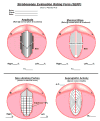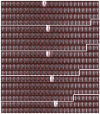Current role of stroboscopy in laryngeal imaging
- PMID: 22931908
- PMCID: PMC3747974
- DOI: 10.1097/MOO.0b013e3283585f04
Current role of stroboscopy in laryngeal imaging
Abstract
Purpose of review: To summarize recent technological advancements and insight into the role of stroboscopy in laryngeal imaging.
Recent findings: Although stroboscopic technology has not undergone major technological improvements, recent clarifications have been made to the application of stroboscopic principles to video-based laryngeal imaging. Also recent advances in coupling stroboscopy with high-definition video cameras provide higher spatial resolution of vocal fold vibratory function during phonation. Studies indicate that the interrater reliability of visual stroboscopic assessment varies depending on the laryngeal feature being rated and that only a subset of features may be needed to be representative of an entire assessment. High-speed videoendoscopy (HSV) judgments have been shown to be more sensitive than stroboscopy for evaluating vocal fold phase asymmetry, pointing to the future potential of complementing stroboscopy with alternative imaging modalities in hybrid systems. Laryngeal videostroboscopy alone continues to play a central role in clinical voice assessment. Even though HSV may provide more detailed information about phonatory function, its eventual clinical adoption will depend on how remaining practical, technical, and methodological challenges will be met.
Summary: Laryngeal videostroboscopy continues to be the modality of choice for imaging vocal fold vibration, but technological advancements in HSV and associated research findings are driving increased interest in the clinical adoption of HSV to complement videostroboscopic assessment.
Figures




References
-
- Zeitels SM. Premalignant epithelium and microinvasive cancer of the vocal fold: The evolution of phonomicrosurgical management. Laryngoscope. 1995;105:1–51. - PubMed
-
- Wendler J. Stroboscopy. J Voice. 1992;6:149–154.
-
- Oertel M. Das Laryngo-stroboskop und die laryngo-stroboskopische Untersuchung [The laryngo-stroboscope and laryngostroboscopic examination] Arch Laryng Rhinol. 1895;3:1–16.
-
- Mehta DD, Deliyski DD, Hillman RE. Commentary on why laryngeal stroboscopy really works: Clarifying misconceptions surrounding Talbot’s law and the persistence of vision. J Speech Lang Hear Res. 2010;53:1263–1267. This commentary clears up misconceptions in the voice literature regarding the physical principles behind laryngeal stroboscopic imaging. Erroneous references to Talbot’s law and the persistence of vision are supplanted by the relevant visual-perceptual phenomena of critical flicker frequency and apparent motion. - PMC - PubMed
Publication types
MeSH terms
Grants and funding
LinkOut - more resources
Full Text Sources
Other Literature Sources
Research Materials
Miscellaneous
